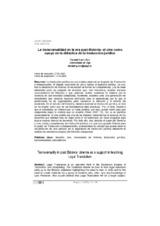Mostrar el registro sencillo del ítem
La transversalidad en la era post-Bolonia: el cine como apoyo en la didáctica de la traducción jurídica
| dc.contributor.author | García Oya, Elisabet | |
| dc.date.accessioned | 2021-07-22T10:22:59Z | |
| dc.date.available | 2021-07-22T10:22:59Z | |
| dc.date.issued | 2020 | |
| dc.identifier.issn | 2255-3703 | |
| dc.identifier.uri | http://hdl.handle.net/10396/21521 | |
| dc.description.abstract | La traducción jurídica es una materia esencial en el grado de Traducción e Interpretación. Al debate recurrente de cómo formar al traductor jurídico, se une, tras la declaración de Bolonia, la necesidad de formar en competencias, y la de crear materiales para un conjunto de alumnos que, con frecuencia, poseen escasos conocimientos de Derecho y que, además, suelen comenzar la materia con la creencia de que resultará complicada. Asimismo, estamos ante una generación de estudiantes que necesita mayores estímulos para el aprendizaje, por lo que el profesorado ha de ingeniárselas para conservar la atención y el interés del alumnado. En el estudio del Derecho, materia esencial en traducción jurídica, el cine se ha erigido como una de las herramientas más atractivas. Por un lado, favorece que el estudiante se interese por un tema jurídico; por otro, puede servir para que comprenda mejor la materia que se enseña (Pérez 2007: 74). Así, si se planifica correctamente, el cine podría ser una de las mejores herramientas al alcance de los docentes que además han de dejar atrás el rol tradicional de clase magistral para buscar nuevas formas de docencia. Por todo ello, tras abordar el papel del Derecho y cine, de las competencias en traducción jurídica y lo que ha supuesto Bolonia para el grado de Traducción e Interpretación, analizaremos la utilidad que puede tener la visualización de una película en la asignatura de traducción jurídica mediante el análisis de elementos propios del Derecho comparado. | es_ES |
| dc.description.abstract | Legal Translation is an essential field in the Bachelor’s Degree of Translation and Interpreting. The traditional debate on how to train legal translator adds up to the Bolonia statement highlighting the need to train in skills and to the need to create materials for a group of students who, often, lack any knowledge of Law. Moreover, they usually believe that Legal Translation will be a tough subject.Likewise, we are before a generation which needs more stimulus to learn, so that teachers must come up with ways of keeping students’ attention and interest. In the study of law, related to the subject of legal translation, cinema has become one of the most attractive tools. On the one hand, it increases the interest of the student for a legal subject. On the other, it can allow them to better understand the issue. If well planned cinema can becomeone of the best tools for teachers, who must leave behind the traditional role of master lecture to look for new ways of teaching. So, after dealing with the role of Law and Cinema, the skills in legal translation and what Bologna has meant for the Bachelor’s Degree of Translation and Interpreting, we will analyse why a film in the subject of legal translation can be useful through the analysis of compared law specific elements | es_ES |
| dc.format.mimetype | application/pdf | es_ES |
| dc.language.iso | spa | es_ES |
| dc.publisher | UCOPress | es_ES |
| dc.rights | https://creativecommons.org/licenses/by/3.0/ | es_ES |
| dc.source | Skopos 11, 121-138 (2020) | es_ES |
| dc.subject | Derecho | es_ES |
| dc.subject | Cine | es_ES |
| dc.subject | Declaración de Bolonia | es_ES |
| dc.subject | Traducción jurídica | es_ES |
| dc.subject | Transversalidad | es_ES |
| dc.subject | Competencia | es_ES |
| dc.subject | Skills. | es_ES |
| dc.subject | Law | es_ES |
| dc.title | La transversalidad en la era post-Bolonia: el cine como apoyo en la didáctica de la traducción jurídica | es_ES |
| dc.title.alternative | Transversality in post Bolonia: cinema as a support in teaching Legal Translation | es_ES |
| dc.type | info:eu-repo/semantics/article | es_ES |
| dc.relation.publisherversion | https://www.uco.es/ucopress/ojs/index.php/skopos/index | es_ES |
| dc.rights.accessRights | info:eu-repo/semantics/openAccess | es_ES |

